Escape to the Châteaux in the Dordogne & the Lot
February 22nd, 2018Would you like to live in a Château?
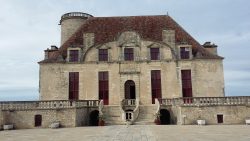
Château Duras
It is autumn 2018 and it has been a miserable and wet summer in the UK. I do not think there has been one week when it has not rained. They say it has something to do with the ‘Gulf Stream’ not reaching as high as it normally does off the coast of England! What ever the reason it is a delight to escape and be touring the Châteaux of the Dordogne and the Lot in brilliant sunshine. I had previously known a colleague who bought a vineyard and Château about forty miles from Bordeaux. It was amazingly cheap – about two hundred thousand pounds. Perhaps the French are not so keen on the maintenance of a Château? I would love to live in a French Château; it would be such an adventure.
Where are all the retirees?
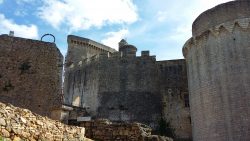
Château de Bonaguil
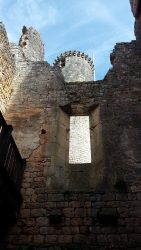
Château de Bonaguil
The Château de Bonaguil is a top destination for anyone staying in the Dordogne and the Lot area. The first known document testifying to the existence of Bonaguil dates from 1271 but at the time it would have been a fortified place with a simple stone tower. It was mainly established by Berenger de Roquefeuil (1448-1530) who spent 30 years making it the fortress of legend it is today, although it was altered again in the second half of the XVIIIth century by Marguerite de Fumel. It is situated 7 kms from the town of Fumel. There is a real sense of the evolution of the Château over the centuries as different parts have been preserved relating to when that part of the fortress was constructed. What surprises me is how few people are visiting on the day we are there. It is out of season in October but an equivalent National Trust property in England would be packed with visitors. Where are all the French retirees?
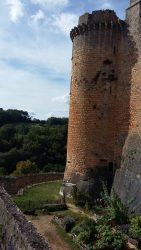
Château de Bonaguil
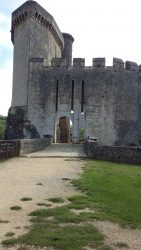
Château de Bonaguil
It is not a place to visit if you have limited mobility as there are a lot of steep steps to climb over rough stones. I am surprised how small some of the rooms are such as The Great Hall which also gives access to the Graffiti room which I found fascinating. The living conditions must have been very cramped. The descriptions of the various spaces are in English and French and cleverly capture the time when various sections were built. The well which is 45 meters deep and 2 meters wide is dug into the rock and fed by rainwater. This supply of freshwater was the main reason why the fortress was established here and managed to survive over several centuries.
Château Monbazillac
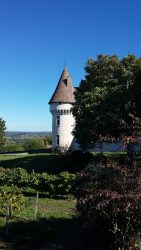
Château Monbazillac
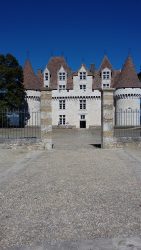
Château Monbazillac
Château Monbazillac is about 6kms south of Bergerac set in fields of vineyards. It is a renaissance Château built in the 16th century. Unusually it is open all year round as most of the other chateaux in the area close at the end of October and reopen in the Spring. It is by far the busiest chateau I have visited in the area and the visitors seem to come from all round the world. Part of the attraction is to taste the wines grown in the private vineyards as well as exploring the house. The place was a Protestant stronghold in the Huguenot War of Religions (1562-1598). It is full of impressive furnishings and a few are original pieces of furniture. There are some delightful fireplaces and the library has the family tree of the D’Aydies, the founders of the castle.
Nearby is the village of Monbazillac and we are sitting in the garden of a local cafe drinking tea. This cafe closes at the end of October and serves wine and sells souvenirs. I buy myself a cap to wear for tennis for when the sun is shining in my eyes. The girl that serves us also finishes her job at the end of the month and at this time does not have another job to go to. I suspect she is typical of a lot of other young people working in the area moving through a series of temporary jobs to make a living.
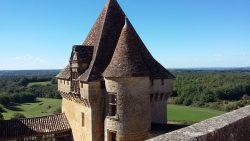
Château de Biron
‘Gravity reversed’
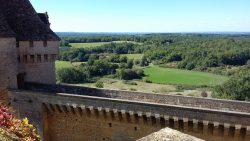
Château de Biron
Eight kms south of Monpazier is Château de Biron which dominates the countryside for miles around. It was originally constructed in the eleventh century and added to piecemeal over the years by the Gontaut-Biron family, who occupied it up until the early Twentieth century.
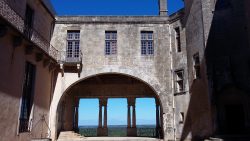
Château de Biron
The chateau is entered via an internal courtyard around which are the castle buildings, the caretaker’s tower and the church. You can see evidence of building from different periods with the church not having been built until the 16th century at about the same time that the caretaker’s tower was being altered. Some of the rooms have been imaginatively set as a tannery, torture chamber and a weavers area.

Saul Steinberg, ‘Gravity Reversed’
However what I found most interesting was an exhibition of paintings including a cartoon by Saul Steinberg of ‘gravity reversed’. Unfortunately you were not allowed to take photographs, so a poor copy from the book, published by Paul Steinberg, The New World is attached. It depicts a rolling stone moving uphill chasing a match stick man frantically trying to escape. He therefore inverses the law of universal gravitation and creates a very funny and anarchic picture of the world perhaps we would like to live in. Previously I had never heard of him but he became famous through the publication The New Yorker magazine which published nearly 1,200 0f his drawings.
Château Biron has also been the venue for lots of TV programmes and films. This includes the films ‘The Daughter of D’Artagnan’ (1994), a drama set in 17th century France and Clash of Steel (1962)a 16th century historical action drama. It is easy to see why Château Biron is used as a setting for historical films with stunning views of the surrounding countryside and buildings with such graceful shapes.
An ancient game of pinball
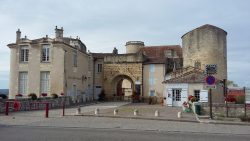
Château Duras
Château Duras is situated in the Dordogne south west of Bergerac and less than an hour’s car journey away. Eymet is another town nearby. The Château is a wonderful attraction for a family to visit as it is so well presented and lots of activities for children and adults to participate in. It even has an ancient pinball machine to play on. It has features such as a stone door which automatically opens as you approach. When I was there the children were obviously having great fun exploring the various rooms and displays helped by lots of easy to follow explanations.
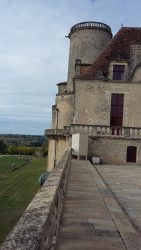
Château Duras
For a long period the Château fell into disrepair. It was originally built in the 12th century and added to in the 14th century making it a fortress. The citizens of Duras showed considerable wisdom and bought the site at a public auction in the 1960s. Many years were spent restoring the château to its former glory and is now visited by visitors from all over the world. If only some of the castles in the UK were as imaginatively displayed as Château Duras. The visitor is not only informed of the historical context but drawn into the time and place with lots of fun games and objects. What a marvellous achievement.
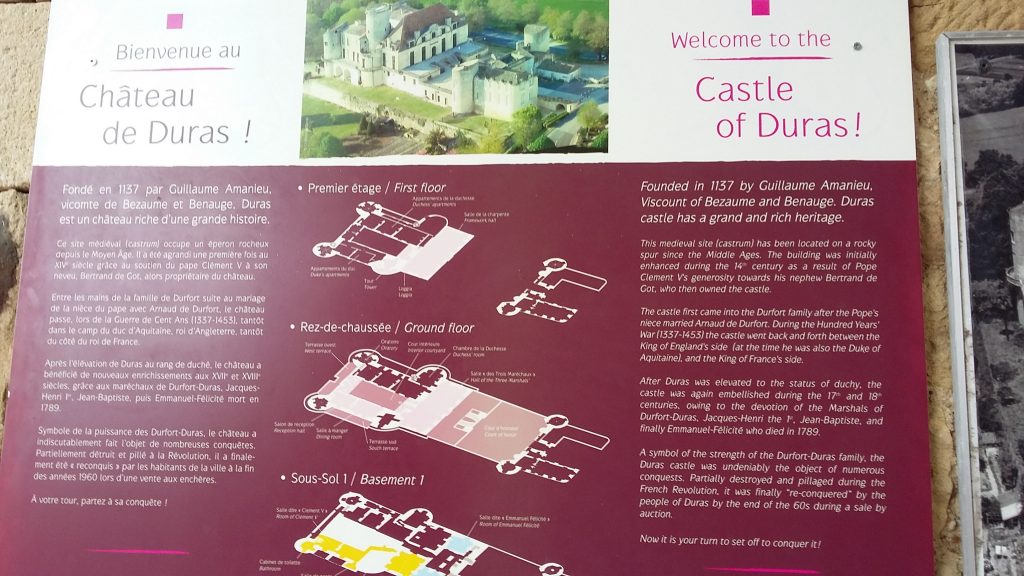
Château de Duras
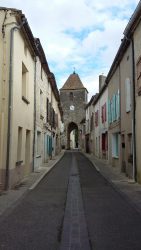
Village of Duras
The village of Duras is just a few hundred yards walk from the Château. It has lots of great restaurants and cafés where you can sit outside, enjoy your food and watch the world go by. A lot of English have settled here to live and you can see the attraction as it is very picturesque. I however prefer the towns such as Eymet which seem a little more authentic with lots of amenities nearby.
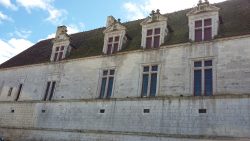
Lauzun Castle
Make sure you check the opening times
Lauzun Castle is privately owned and only opens in July and August in the afternoons. This is unusual but it is well worth checking opening times before you visit. It is situated in the pretty village of Lauzun less than 20 kms south of Bergerac and 4 kms west of Castillonnès.
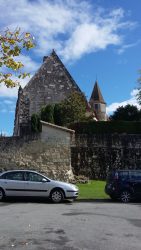
Lauzun Castle
There was a settlement at Lauzun Castle from Roman times but it gained in importance from the 13th century onwards, at which stage the local lords started to develop the small castle into a major defensive structure. In the 15th and 16th century the castle was transformed into a stately home to make it more comfortable to live in.
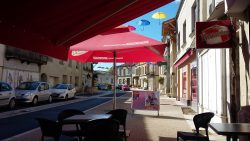
Village of Lauzun
I hope you have enjoyed my mini tour of the châteaux in this region. There are many more but hopefully this ‘taster’ will provide an incentive for you to visit the region and visit these castles, many of which are still in their medieval condition.
If you would like to stay in Airbnb in this part of France please click here

